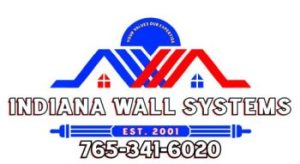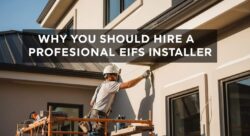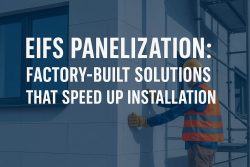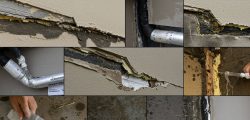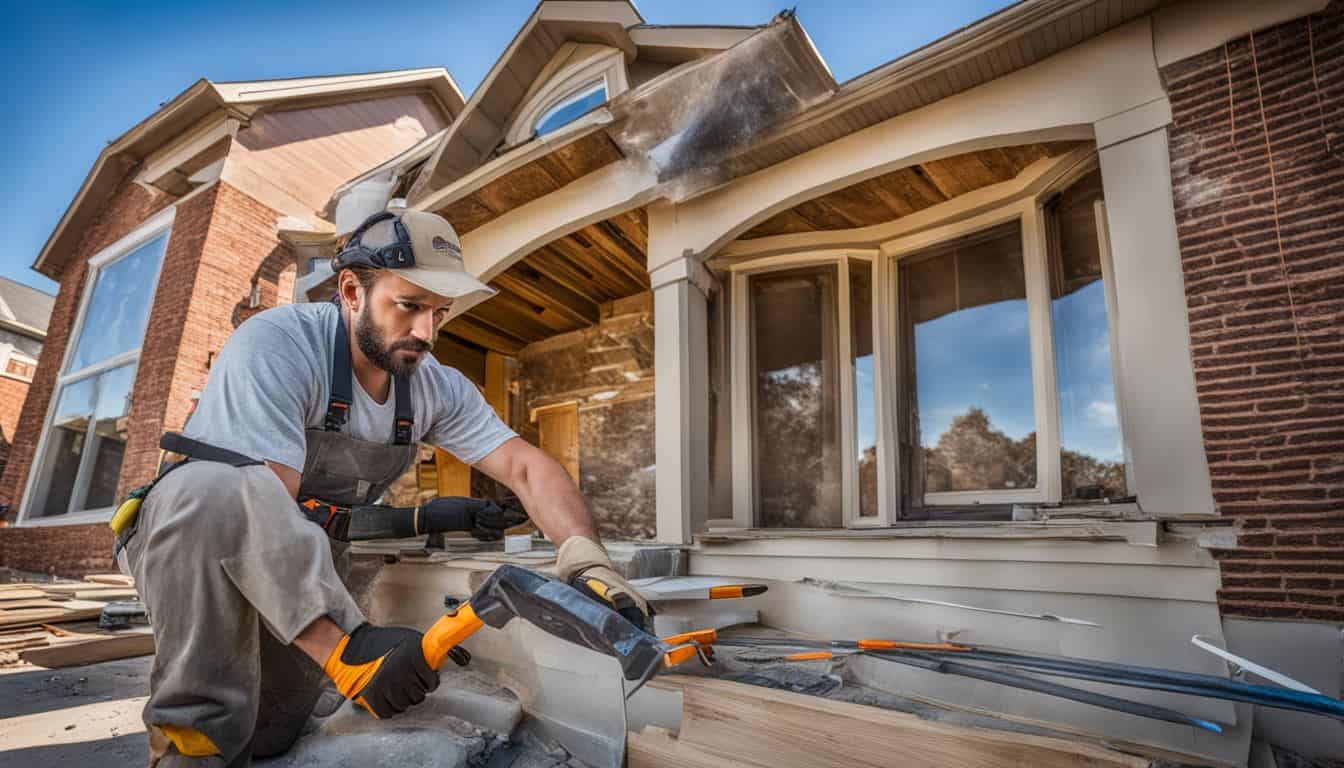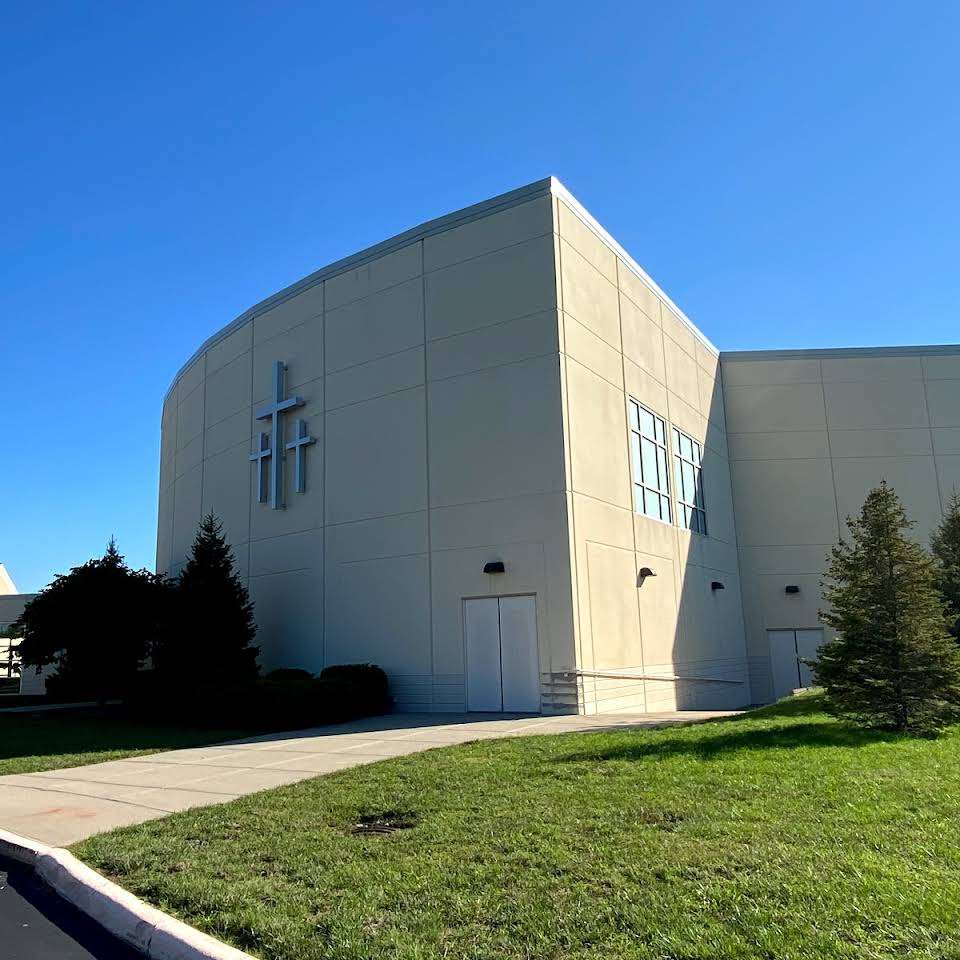Expert Tips to Combine EIFS with Brick, Stone, or Siding Without Compromising Style or Structure
Creating a stunning exterior that combines EIFS (Exterior Insulation and Finish System) with other materials isn’t just about aesthetics—it’s about mastering the technical details that prevent costly failures down the road. After 22 years in the EIFS business, I’ve seen countless projects where homeowners and contractors attempted to blend materials only to face expensive repairs within a few years.
The key to success lies in understanding how different materials interact, move, and weather over time. When done correctly, mixing EIFS with brick, stone, or siding creates architectural depth that can transform an ordinary building into a showpiece.
Key Takeaways
- Proper flashing and drainage plane continuity prevents 90% of moisture-related failures at material transitions
- Control joints at material changes accommodate differential movement between EIFS and adjacent cladding
- Color harmonization strategy ensures visual cohesion across different textures and materials
- Sealant-compatible terminations with backer rod create long-lasting weatherproof seals
- Professional installation following AIMA guidelines protects your investment and warranty coverage
Key Success Factors
- ✓ Proper flashing and drainage plane continuity prevents 90% of moisture-related failures
- ✓ Control joints at material changes accommodate differential movement
- ✓ Color harmonization strategy ensures visual cohesion across materials
- ✓ Professional installation protects your investment and warranty
Understanding EIFS as a Foundation Material
EIFS provides exceptional design flexibility that makes it an ideal base for mixed-material exteriors. Unlike traditional stucco, the synthetic stucco system offers continuous insulation and superior energy efficiency while serving as a canvas for architectural creativity.
The exterior insulation and finish system consists of several critical layers:
- Substrate preparation with proper moisture content testing
- Insulation board attachment with corrosion-resistant fasteners
- Base coat with embedded reinforcement mesh
- Finish coat designed for weather resistance and aesthetics
EIFS System Components
Substrate
Proper moisture testing & preparation
Insulation Board
Continuous thermal barrier
Base Coat + Mesh
Impact resistance & durability
Finish Coat
Weather protection & aesthetics
What sets modern EIFS systems apart is their ability to accommodate movement while maintaining weatherproof integrity. This characteristic makes EIFS particularly well-suited for combination applications when properly detailed.
Planning Your Mixed-Material Design
Material Compatibility Assessment
Before selecting complementary materials, consider these compatibility factors:
| Material Type | Thermal Movement | Moisture Management | Attachment Method |
|---|---|---|---|
| EIFS | Minimal expansion | Water-managed system | Mechanical fasteners |
| Brick Veneer | Moderate expansion | Cavity drainage | Ties to structure |
| Natural Stone | Low movement | Varies by installation | Mechanical anchors |
| Fiber Cement | Low expansion | Sealed joints | Direct fastening |
| Vinyl Siding | High expansion | Overlapped drainage | Floating attachment |
Design Principles for Seamless Integration
Architectural details should guide material placement rather than arbitrary divisions. Consider these proven approaches:
- Horizontal bands that follow roof lines or floor separations
- Vertical accents around entries, windows, or structural elements
- Corner treatments that establish visual anchors
- Wainscot applications that protect high-wear areas
Jeff Johnson notes, “The most successful mixed-material projects follow natural break lines in the architecture. Fighting the building’s proportions always looks forced and creates more technical challenges.”
Essential Technical Details for Material Transitions
Flashing and Moisture Management
Properly lapped flashing at every material transition prevents water intrusion that can compromise both EIFS and adjacent materials. Critical flashing locations include:
- Kick-out flashing at roof-wall intersections
- Sill pan flashing under all window and door openings
- Through-wall flashing at material change lines
- Termination bar detailing where EIFS meets other cladding
The drainage plane continuity must remain unbroken across material changes. This requires careful coordination between trades and thorough understanding of each system’s water management strategy.
Control Joint Strategy
Expansion joint placement accommodates differential movement between materials with different thermal coefficients. Position control joints at:
- Material transition lines
- Building corners and offsets
- Window and door openings
- Maximum 150-foot intervals on long walls
Sealant failure pathways often result from inadequate joint design rather than product defects. Use backer rod and joint sealant sized for expected movement, typically 25% of joint width.
Attachment and Load Transfer
Each material must transfer loads safely to the structural framing without compromising adjacent systems. Load transfer considerations include:
- Wind loads on different materials
- Seismic movement accommodation
- Thermal movement cycles
- Dead load of heavier materials like stone
Combining EIFS with Specific Materials

EIFS and Brick Combinations
Transition details between EIFS and brick require careful attention to different expansion characteristics. Brick expands more than EIFS, necessitating proper joint design.
Best practices include:
- Weep screed alignment at the base of both systems
- Continuous vapor barrier behind both materials
- Reveal bead at cladding breaks for clean visual separation
- Metal flashing transitions lapped properly into both systems
Common applications pair EIFS on upper floors with brick wainscoting for durability and visual weight. This approach provides cost savings compared to full brick construction while maintaining traditional aesthetics.
Stone Veneer Integration
Natural stone accents create dramatic focal points when combined with EIFS backgrounds. Faux stone accents with EIFS offer similar visual impact at reduced cost and weight.
Critical details for stone-EIFS transitions:
- Capillary break at interfaces prevents moisture wicking
- Adequate structural support for stone weight
- Substrate-to-masonry tie-ins properly engineered
- Sealant joints designed for stone’s minimal movement
Fiber Cement and EIFS Pairing
Fiber cement panels offer excellent compatibility with EIFS due to similar expansion characteristics and installation methods. This combination works particularly well for contemporary designs requiring clean lines and contrasting textures.
Successful fiber cement and EIFS combinations typically feature:
- Consistent termination bar detailing at transitions
- Matched sealant systems for similar service life
- Thermal bridging minimization at attachment points
- Coordinated color selections for visual harmony
Our professional EIFS installation services ensure proper integration of multiple cladding systems following manufacturer specifications.
Advanced Installation Techniques
Sequencing Trades for Quality
Pre-construction coordination meetings prevent conflicts between different material installations. Establish clear responsibilities for:
- Substrate preparation shared between systems
- Flashing installation and overlap details
- Quality control punch lists for each material
- Curing time requirements between applications
Mock-Up Testing
Mock-up wall section testing validates design details before full-scale installation. Test sections should include:
- Complete wall assemblies from structure to finish
- All flashing and sealant details
- Ambient temperature variations during installation
- Water testing to verify moisture management
Texture and Color Coordination
Texture matching across materials requires careful planning and sampling. Consider how different materials will weather and fade over time.
Color harmonization strategies:
- Sample all materials under various lighting conditions
- Account for UV fading differences between material types
- Consider maintenance requirements for color retention
- Plan for repainting compatibility with existing finishes
Common Mistakes and How to Avoid Them
Critical Failure Points
❌ Poor Joint Design
Sealant failure from inadequate preparation
💧 Inadequate Flashing
Water intrusion at material transitions
🌡️ Thermal Gaps
R-value discontinuity reduces efficiency
Poor Joint Design
Sealant adhesion failure typically results from inadequate joint preparation or wrong sealant selection. Always use:
- Three-sided bond breaker (backer rod) in all joints
- Sealants compatible with both adjacent materials
- Proper joint width for expected movement
- Primer systems when required by sealant manufacturer
Inadequate Flashing
Water intrusion behind mixed materials often traces to flashing discontinuities. Ensure:
- Continuous water-resistant barrier behind all materials
- Proper lapping sequence directing water outward
- End dam details at flashing terminations
- Regular inspection during construction
Thermal Performance Gaps
R-value continuity across the facade prevents thermal bridging that reduces energy efficiency. Maintain:
- Continuous insulation alignment between systems
- Thermal break details at structural connections
- Proper air sealing at material transitions
- Vapor permeability balance across the wall assembly
For properties experiencing these issues, our comprehensive EIFS repair services can restore performance and appearance.
Design Ideas for Popular Combinations
Traditional Elegance: EIFS and Brick
Classic combinations place brick on lower portions with EIFS above, creating visual weight and protecting high-wear areas. Architectural foam profiles can bridge between materials with cornice details or banding.
Popular applications include:
- Colonial revival with brick first floor, EIFS upper levels
- Tudor styling using brick accents with EIFS field areas
- Commercial buildings with brick base and EIFS curtain walls
Contemporary Contrast: EIFS and Metal Panels
Modern designs often feature EIFS backgrounds with metal panel accents for striking contrast. This combination offers:
- Clean lines emphasizing architectural geometry
- Maintenance advantages with dissimilar materials
- Energy code compliance through continuous insulation
- Cost efficiency compared to all-metal facades
Rustic Charm: EIFS and Stone
Natural stone wainscoting with EIFS upper walls creates appealing rustic aesthetics while providing practical benefits:
- Pest intrusion deterrents with stone base protection
- Hail impact resistance in vulnerable lower areas
- Visual connection to natural landscaping materials
- Long-term durability in high-traffic zones
Popular Design Combinations
Traditional Elegance
EIFS + Brick
Classic combination with brick base and EIFS upper levels for timeless appeal
Contemporary Contrast
EIFS + Metal Panels
Modern designs featuring clean lines and striking material contrast
Rustic Charm
EIFS + Natural Stone
Stone wainscoting with EIFS creates appealing rustic aesthetics
Maintenance Considerations for Mixed Materials
Coordinated Cleaning Programs
Different materials require specific cleaning and maintenance protocols. Develop coordinated programs addressing:
- Pressure washing limitations for EIFS versus other materials
- Chemical compatibility between cleaning products
- Resealing schedules for sealant joints
- Inspection frequencies for each material type
Long-Term Performance Planning
Sealant joint lifecycle planning prevents premature failures. Plan for:
- 10-15 year sealant replacement cycles
- Coordinated repainting when materials reach service limits
- Preventive maintenance to extend material life
- Performance monitoring for early problem detection
📅 Maintenance Timeline for Mixed Materials
Years 1-5: Basic Maintenance
Annual cleaning, sealant inspection, minor touch-ups
Years 10-15: Sealant Replacement
Major sealant joints, selective repainting, system evaluation
Years 20+: Major Renewal
Complete recoating, flashing updates, system upgrades
Our expert maintenance services help property owners develop cost-effective long-term care programs.
Code Compliance and Safety
Building Code Requirements
NFPA 285 compliant wall sections may be required for buildings over certain heights. Ensure mixed-material assemblies meet:
- Fire resistance ratings for the building type
- Energy code requirements (IECC) for continuous insulation
- Local building department approval for custom assemblies
- Weather barrier code requirements for the climate zone
Warranty Considerations
Warranty compliance requires following manufacturer installation guidelines precisely. Maintain:
- Documentation of approved material combinations
- Installation photos showing proper details
- Material certifications for all components used
- Professional installation by certified applicators
Cost Analysis: Mixed Materials vs. Single Systems
Initial Investment Comparison
| System Type | Cost Range ($/sq ft) | Installation Complexity | Design Flexibility |
|---|---|---|---|
| EIFS Only | $8-15 | Standard | High |
| EIFS + Brick | $12-25 | Moderate | Very High |
| EIFS + Stone | $15-35 | High | Extremely High |
| EIFS + Fiber Cement | $10-20 | Moderate | High |
• Prices may vary based on regional labor rates and material availability
• Complex architectural details may increase costs by 15-30%
• Energy efficiency improvements can offset higher initial investment
Long-Term Value Considerations
Mixed-material exteriors often provide superior return on investment through:
- Enhanced curb appeal increasing property values
- Reduced maintenance costs with appropriate material placement
- Energy savings from optimized thermal performance
- Durability improvements using materials suited to each exposure
Properties in Carmel and Fishers consistently show strong appreciation with well-designed mixed-material exteriors.
Environmental and Sustainability Benefits
Energy Performance Optimization
EIFS provides continuous insulation that dramatically improves energy efficiency when properly integrated with other materials. Benefits include:
- Thermal bridging reduction compared to traditional construction
- Air leakage reduction through continuous barrier systems
- Hygrothermal performance optimized for Indiana’s climate
- LEED point opportunities for green building certification
Sustainable Material Selection
Consider environmental impact when selecting complementary materials:
- Recycled content in fiber cement and metal panels
- Local sourcing for stone and brick materials
- Low-emission sealants and finishes
- End-of-life recyclability for future renovations
Technology Integration and Future Trends
Smart Building Integration
IoT integration opportunities exist with mixed-material facades through:
- Moisture sensors at critical transition details
- Temperature monitoring for thermal performance validation
- Maintenance scheduling based on actual conditions
- Energy monitoring for optimization opportunities
Innovative Materials and Methods
Emerging technologies expanding design possibilities include:
- 3D-printed architectural elements for custom transitions
- Advanced sealant systems with longer service life
- Smart coatings that respond to environmental conditions
- Modular systems reducing installation complexity
For cutting-edge applications, explore our innovative EIFS solutions incorporating the latest technologies.
Working with Professional Contractors
Selecting Qualified Installers
Professional EIFS installation requires specialized knowledge and experience. Look for contractors with:
- EIMA certification for EIFS installation
- Manufacturer training certificates
- Local references for mixed-material projects
- Insurance coverage adequate for project scope
Project Management Best Practices
Successful mixed-material projects require:
- Detailed specifications covering all material interfaces
- Regular progress meetings coordinating multiple trades
- Quality inspections at critical installation milestones
- Clear communication with all stakeholders
Jeff Johnson
CEO, Indiana Wall Systems | 22 Years EIFS Experience
“The contractor you choose should demonstrate expertise in both EIFS installation and the complementary materials. Generic contractors often miss critical details that lead to expensive callbacks.”
Regional Considerations for Indiana Properties
Climate-Specific Design
Indiana’s four-season climate presents unique challenges for mixed-material facades:
- Freeze-thaw cycles affecting sealant performance
- High humidity requiring proper vapor management
- Temperature extremes causing differential material movement
- UV exposure variations affecting color stability
Local Building Practices
Central Indiana construction typically features:
- Concrete masonry substrate construction
- Wood frame with engineered sheathing systems
- Regional material preferences for brick and stone
- Energy efficiency requirements driving EIFS adoption
Our experience serving Indianapolis and surrounding communities has refined our understanding of successful material combinations for this climate.
Frequently Asked Questions
Can EIFS be applied directly next to vinyl siding?
EIFS and vinyl siding transitions require careful detailing due to vinyl’s high thermal expansion. Use flexible sealants and properly sized control joints to accommodate movement differences.
What’s the best sealant for EIFS-to-brick joints?
Structural glazing sealants or high-performance polyurethane sealants work best for EIFS-brick transitions. Choose products compatible with both materials and rated for exterior weathering.
How do you prevent water damage at material transitions?
Continuous flashing systems with proper overlap sequences direct water away from vulnerable areas. Never rely on sealants alone for water protection.
Can different texture patterns be matched between materials?
Texture coordination requires careful sampling and may involve custom applications. Work with experienced applicators familiar with matching techniques across different material types.
What building codes apply to mixed-material exteriors?
Local building codes vary, but most require compliance with IECC energy requirements and fire safety standards. Consult your building department for specific requirements.
How often do sealant joints need replacement?
Sealant replacement cycles typically range from 10-20 years depending on exposure, material quality, and installation quality. Regular inspection helps identify early replacement needs.
Ready to transform your property with a seamless mixed-material exterior? Contact Indiana Wall Systems at (765) 341-6020 for a comprehensive consultation. Our 22 years of EIFS experience and proven track record with complex material combinations ensure your project achieves both aesthetic goals and long-term performance.
Ready to Transform Your Property?
Get expert consultation for your mixed-material exterior project
We serve Zionsville, Plainfield, and communities throughout Central Indiana with professional installation backed by comprehensive warranties. Don’t risk your investment with inexperienced contractors—choose the EIFS specialists who understand how materials work together for lasting success.
